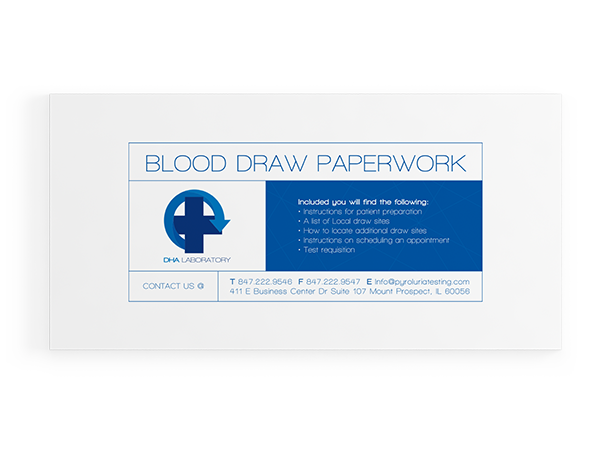Lab Testing
Product Description
**Note: All laboratory testing requires an authorizing physician. DHA Laboratory offers a patient direct program that partners you with an authorizing physician. If you have any additional questions regarding the availability of testing, please contact our laboratory by telephone or email.**
Copper serum is one of the diagnostic methods of ascertaining whether a patient is suffering from some kind of liver problem or from a genetic disease called Wilson’s disease.
(Copper Toxicity, Copper Overload, Copper Serum, Hair Analysis, Percentage of Free Copper, Eliminating Copper, Copper Overload Symptoms, Related Testing)
Understanding and Measuring Copper:
Copper serum is a highly reliable blood test that directly relates to brain chemistry. Elevated copper levels can alter the brain’s function, specifically the activity of dopamine and norepinephrine. Copper plays a large role in the metabolism of dopamine and the synthesis of norepinephrine. In turn, elevated copper levels lower dopamine levels and raise levels of norepinephrine. Imbalances in these essential brain chemicals have been related to paranoid schizophrenia, bi-polar disorder, postpartum depression, ADD, ADHD, autism, and violent aggressive behavior. Copper serum levels can single handedly be the root cause of an individual condition, but elevated copper serum levels are also known to cause zinc levels to deplete and oxidative stress to rise.
Hair analysis results provide copper levels, but hair analysis is a poor determination of free copper. Copper experts believe the most accurate ways to determine copper levels are to measure both copper serum and Ceruloplasmin. Ceruloplasmin is the major copper-carrying protein found in the blood. These two results can be plugged into an equation, which reveals the percentage of free copper.
“Hair analysis ALONE is a very poor way to assess copper status. I say this after (a) evaluating more than 100,000 hair analyses, (b) developing the first high-quality hair standards (loaned to NIH and other researchers), and (c) performing numerous double-blind, controlled experiments involving hair chemistries. Findings of high Cu levels in hair are compromised by the many external sources of Cu which cannot be completely removed by washing. Low levels of Cu in hair and/or blood often are coincident with dangerous overloads of Cu in liver. Hair Cu values can provide information of clinical significance, but by itself is not clinically decisive.”, Bill Walsh, PhD, Pfeiffer Treatment Center
Percentage of free Copper:
The amount of free serum copper is the amount of unbound copper circulating in the blood, which is unbound by Ceruloplasmin. This is the copper that is “free” to accumulate in the liver and other organs. A free copper percentage above 20% is classified as elevated and outside of the optimal range.
- 5 to 20% = normal
- 20 to 30% = high normal
- 30 to 40% = elevated (high oxidative stress)
- > 50% = severe elevation (severe oxidative stress)
The calculation for free copper is as follows:
(Total Serum Copper in ug/dl) – (Ceruloplasmin in mg/dl x 3) / Copper serum =
Related Testing:
Symptoms of Copper Overload (Nutrient Power: Heal Your Biochemistry and Heal Your Brain, Dr. William J. Walsh):
- Skin sensitivity to metal and fabric
- Hyperactivity
- Academic underachievement
- Estrogen intolerance
- Emotional meltdowns
- Ringing in ears
- Sensitivity to food dyes
- High anxiety
- Sleep problems
- Adverse reactions to supplements containing copper
- Abnormal menstrual periods
It is essential to not only examine copper serum, but also examine levels of zinc plasma, whole blood histamine, pyrroles, and Ceruloplasmin. Accurate results from these key laboratory tests are the first step into balancing brain chemistry with nutrient therapy. When administered properly, the advanced nutrient therapy treatment model is natural, effective, and relatively free of side effects.
Elevated copper serum levels are also known to cause zinc levels to deplete. Maintaining a healthy copper to zinc ratio is extremely important for healthy brain function. So, it is essential to not only examine copper serum, but also examine levels of zinc plasma.
Patient Preparation: A fasting specimen is preferred, but not required. Patients can fast for 12 hours prior to specimen collection. Supplements containing vitamins or minerals should be stopped 12-24 hours prior to your blood draw. Do not avoid supplements for longer than 24 hours. Sports drinks and energy drinks such as Redbull or Vitamin Water are known to contain levels of vitamins and minerals that would classify them as supplements. Please look at the vitamin and mineral information on your products. If they are considered a supplement, like Ensure, please discontinue them 12 hours prior to specimen collection. Anti-histamines, if approved by your practitioner, should be stopped 21 days prior to your blood draw.

